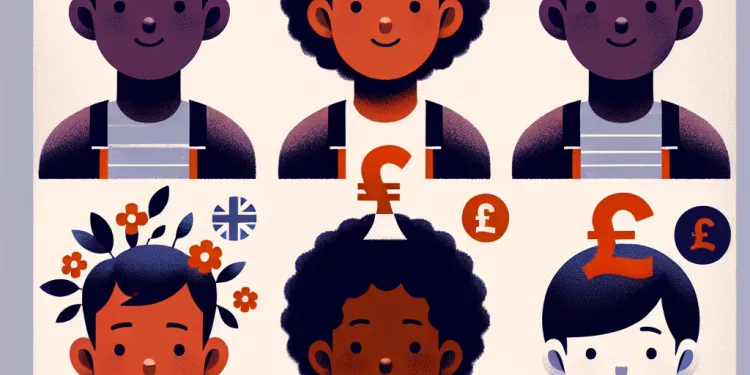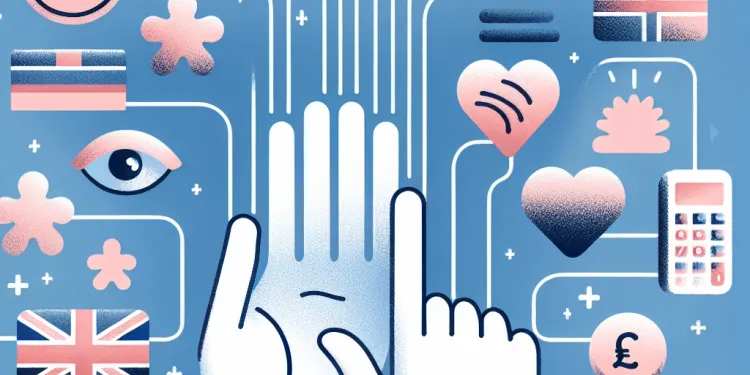
Find Help
More Items From Ergsy search
-

Is autism more common in boys or girls?
Relevance: 100%
-

Is ADHD more common in boys or girls?
Relevance: 72%
-

What is Autism?
Relevance: 42%
-

What is the autism spectrum?
Relevance: 40%
-

Autism - My Story - Rosalind | NHS
Relevance: 40%
-

How prevalent is autism?
Relevance: 39%
-

What advice is available for parents concerned about autism risks?
Relevance: 35%
-

Is there an autism test?
Relevance: 32%
-

Is there a genetic component to autism?
Relevance: 31%
-

What causes autism?
Relevance: 31%
-

Can autism be cured?
Relevance: 31%
-

What are the signs of autism?
Relevance: 30%
-

How is autism diagnosed?
Relevance: 30%
-

Are vaccines linked to autism?
Relevance: 30%
-

Can adults have autism?
Relevance: 30%
-

Autism: Graeme's story | NHS
Relevance: 30%
-

Is paracetamol linked to autism?
Relevance: 29%
-

Autism - My Story - Adrian | NHS
Relevance: 29%
-

What can cause autism, if not paracetamol?
Relevance: 29%
-

How does autism affect communication?
Relevance: 28%
-

What are some common therapies for autism?
Relevance: 28%
-

Can people with autism lead independent lives?
Relevance: 27%
-

What is the difference between autism and Asperger's syndrome?
Relevance: 27%
-

Autism Assessment - What Happens in Your Appointment
Relevance: 26%
-

What role do sensory issues play in autism?
Relevance: 26%
-

How can families support a member with autism?
Relevance: 26%
-

Is there any scientific evidence that links paracetamol use to autism?
Relevance: 26%
-

The NHS Long Term Plan for learning disability and autism
Relevance: 26%
-

How can early intervention help children with autism?
Relevance: 26%
-

Why is there concern about paracetamol and autism?
Relevance: 26%
-

Is there any risk of using paracetamol outside of pregnancy with regard to autism?
Relevance: 25%
-

What kind of studies are conducted to investigate links between medications and autism?
Relevance: 25%
-

Transforming Care for people with Learning Disabilities and/ or Autism: Peter's Story
Relevance: 22%
-

Are there different types of ADHD?
Relevance: 20%
-

NHS-led Provider Collaboratives: improving mental health, learning disability and autism services
Relevance: 19%
-

What are the limitations of studies examining paracetamol use and autism?
Relevance: 18%
-

Who should get the HPV vaccine?
Relevance: 18%
-

Who can be a victim of honour based abuse?
Relevance: 17%
-

We are autistic | NHS
Relevance: 17%
-

Surge in HPV Vaccination Rates Among Young Women in the UK
Relevance: 16%
Understanding Autism Prevalence in Boys and Girls
Autism Spectrum Disorder (ASD) is a developmental condition that affects communication, behavior, and social interactions. It is known to manifest early in childhood and can have a range of symptoms, varying greatly from one individual to another. Among the general population, autism is diagnosed more frequently in boys than in girls. This difference in prevalence has sparked considerable interest and research worldwide, including in the UK, to understand the underlying causes and implications.
Statistics on Autism Prevalence
In the UK, studies consistently report that autism is more commonly diagnosed in boys compared to girls. The ratio of boys to girls diagnosed with autism is approximately 3:1 or 4:1, meaning that for every girl diagnosed, there are about three to four boys diagnosed with the disorder. This pattern is observed internationally, and similar figures have been reported in several other countries.
Reasons for Gender Disparity
There are several theories as to why autism is more frequently diagnosed in boys than in girls. One suggestion is that girls may be underdiagnosed due to differences in how autism manifests across genders. Girls might display less overt symptoms or may develop better coping strategies to mask their difficulties, making the symptoms less observable. Additionally, the diagnostic criteria for autism have historically been based on male behavior patterns, which might not adequately capture how autism presents in females.
Another consideration is biological and genetic differences. Some researchers propose that there may be genetic or hormonal factors that give rise to the disparity. The "female protective effect" is one such hypothesis, suggesting that females might possess certain genetic or neurobiological factors that provide a buffer against developing autism.
Impact on Diagnosis and Support
The difference in prevalence has significant implications for diagnosis and support services. There is increasing recognition of the need for diagnostic criteria and practices that are sensitive to the female presentation of autism. In the UK, awareness and training are being developed to help clinicians recognize signs of autism in girls more effectively. Early and accurate diagnosis is crucial, as it can lead to better-targeted support and interventions that enhance quality of life.
Conclusion
While autism is more commonly diagnosed in boys, increasing awareness about how autism manifests in girls is essential. Efforts continue in the UK to bridge the gap in diagnosis and to ensure that both boys and girls with autism receive the appropriate support they need. Understanding the nuances of autism prevalence among different genders contributes to more inclusive and effective health and educational practices.
Understanding Autism in Boys and Girls
Autism is a condition that affects how a person talks, behaves, and gets along with others. It shows up when kids are young and looks different for everyone. More boys than girls are told they have autism. This has made people want to learn more about why this happens.
How Common is Autism?
In the UK, more boys are told they have autism than girls. For every girl with autism, there are about three or four boys with it. This is true in other countries too.
Why is Autism More Common in Boys?
There are ideas about why more boys are told they have autism. One idea is that autism looks different in girls, so it's harder to see. Girls might hide their autism better. Also, the way autism is checked might be based on how it appears in boys.
Some think it has to do with body and genes. There might be things in girls' bodies that help protect them from autism.
Effects on Checking and Help
The fact that more boys are told they have autism means we need better ways to notice autism in girls. In the UK, people are working to help doctors see autism in girls earlier. Early help is important because it means better support for those who need it.
Conclusion
Even though more boys are told they have autism, it's important to understand how it looks in girls too. In the UK, people are working to make sure boys and girls with autism get the help they need. Learning about autism in both boys and girls helps make sure everyone gets good care.
Frequently Asked Questions
Is autism more common in boys or girls?
Autism is more commonly diagnosed in boys than in girls.
What is the ratio of boys to girls diagnosed with autism?
The commonly cited ratio is that autism is about 4 to 5 times more common in boys than in girls.
Why is autism more frequently diagnosed in boys?
The exact reasons are not fully understood, but it may involve genetic, hormonal, and diagnostic factors.
Could autism be underdiagnosed in girls?
Yes, autism can be underdiagnosed in girls due to differences in symptom presentation and masking behaviors.
Do boys and girls exhibit autism differently?
Yes, studies suggest that girls may show different symptoms and may be better at compensating or masking their difficulties.
Are there biological reasons for the gender disparity in autism diagnosis?
There may be biological factors such as genetic differences or hormonal influences that affect autism prevalence between genders.
Is the diagnostic criteria for autism biased toward boys?
Some researchers believe that diagnostic criteria may be based on traits more commonly observed in boys, potentially leading to underdiagnosis in girls.
Are girls with autism often diagnosed with other conditions first?
Yes, girls with autism might be misdiagnosed with conditions like anxiety or ADHD before autism is identified.
How does autism prevalence in boys and girls affect research studies?
Research may be skewed towards understanding autism as it appears in boys, potentially missing nuances in how it affects girls.
Has the gender prevalence of autism changed over time?
While more girls are being diagnosed now than in the past, boys are still diagnosed at higher rates.
What steps are being taken to better diagnose autism in girls?
Researchers and clinicians are working on refining diagnostic criteria and understanding gender-specific presentations of autism.
How can parents ensure their daughters are evaluated accurately for autism?
Parents can consult specialists who have experience with girls on the autism spectrum and seek comprehensive assessments.
What role does culture play in autism diagnosis differences between boys and girls?
Cultural expectations and stereotypes about boys and girls may influence how symptoms are perceived and diagnosed.
Can autism be equally severe in both boys and girls?
Yes, the severity of autism can vary widely in both boys and girls, though it may manifest differently.
Are girls with autism more likely to go undiagnosed until later in life?
Some girls with autism may not be diagnosed until adolescence or adulthood due to subtle or nontraditional presentations.
Is there a genetic component to why autism is more common in boys?
Genetic studies suggest there may be factors on the X chromosome or other genetic interactions that could explain the gender disparity.
How do social expectations affect autism diagnosis in boys versus girls?
Boys often face more pressure to be outgoing and social, which can lead to earlier recognition of social difficulties.
Can early intervention be equally beneficial for boys and girls with autism?
Yes, early intervention is beneficial for both boys and girls with autism, though approaches may need to be tailored.
How important is it to have gender-specific autism research?
Gender-specific research can help identify unique challenges and needs faced by girls with autism.
Do boys and girls with autism require different support strategies?
They may benefit from different support strategies tailored to their individual needs, taking into account how their symptoms manifest.
Who has autism more, boys or girls?
More boys have autism than girls.
Helpful Tip: Pictures and videos can help you learn more about autism.
Boys are told they have autism more often than girls.
How many boys have autism compared to girls?
Autism is seen more in boys than in girls. For every girl with autism, there are 4 to 5 boys with it.
Why do more boys get told they have autism?
Doctors find autism in boys more often than in girls.
Autism is how some people’s brains work differently. It is not wrong or bad, just different.
Boys might show autism in a way that is easier for doctors to see.
Girls can show autism in different ways that are harder to notice.
If you want to know more, you can talk to your doctor or teacher.
We don't know the exact reasons why, but it might be because of genes, hormones, or how doctors check things.
Could autism be missed in girls?
Autism helps us understand how some people think and feel. Sometimes, people might not know a girl has autism because it can look different in girls than in boys. This means some girls might not get help as soon as they need it.
It is important to know what autism looks like in girls so they can get the right support. Using tools like pictures, simple words, and talking with someone who knows about autism can help.
Yes, sometimes autism is not noticed in girls. This is because girls can show different signs, and they might hide their feelings and actions.
Do Boys and Girls Show Autism in Different Ways?
Boys and girls can show autism in different ways. This means they might act or behave differently.
- Boys with autism may like things like numbers or trains.
- Girls with autism may like stories or animals and might copy their friends more.
Some helpful tools or tips are:
- Use pictures to help understand feelings.
- Play games that practice talking and listening.
- Tell simple stories to show different feelings.
If you have questions, you can ask a teacher or a grown-up for help.
Yes, studies say that girls can have different signs than boys. Girls might also be better at hiding their struggles.
Why are more boys than girls told they have autism?
There might be body factors, like genes or hormones, that change how many boys and girls have autism.
Are autism tests unfair to girls?
Some scientists think that doctors look for signs of conditions that are easier to see in boys. This means they might miss these conditions in girls.
Do doctors say girls have other problems before autism?
Yes, sometimes people think girls with autism have other things, like being very worried (anxiety) or having trouble paying attention (ADHD), before they know it's really autism.
How does the number of boys and girls with autism change research studies?
Research might focus too much on how autism looks in boys. This means we might not see all the ways it shows up in girls.
Have more boys or girls had autism over time?
Let's find out if more boys or girls have been diagnosed with autism over the years.
Some tools can help people understand better:
- Look at pictures or graphs to see numbers.
- Ask someone to explain if you're unsure.
- Use apps that read text out loud.
More girls are getting diagnosed now than before. But boys still get diagnosed more often than girls.
How are doctors getting better at finding autism in girls?
Scientists and doctors are learning how to better identify autism and understand how it can look different in boys and girls.
How can parents make sure their daughters are checked right for autism?
Parents can help their daughters by talking to doctors or teachers. It's important to watch for signs like trouble talking or playing with friends.
Parents should ask for tests if they think their daughter might have autism. It's okay to ask questions and get second opinions.
Using picture books or apps can help explain things in a simple way. Always stay patient and supportive with your daughter.
Parents can talk to experts who know about girls with autism. These experts can check and help.
How does culture affect autism diagnosis in boys and girls?
Culture means the way people live, like their ideas, languages, and traditions.
Sometimes, culture can make it harder to see autism in girls than in boys.
Here are some ways culture might change how we see autism in boys and girls:
- Some cultures expect girls to behave quietly. They might miss signs of autism.
- Boys might show autism signs differently, and more obviously, than girls.
- In some places, people think only boys can have autism.
To learn more, you can use picture cards or watch videos about autism. You can also talk to a teacher or doctor for help.
How people think about boys and girls can change how they see signs of problems. This can also affect if and how they get help.
Can boys and girls have autism the same amount?
Autism is something that makes people think and feel differently. It can be different for everyone.
Both boys and girls can have autism. Sometimes it might look different in boys than in girls.
Some people think boys show autism more clearly. Girls might hide it better or show it in other ways.
Everyone with autism is different. It's important to listen to doctors and experts to understand better.
If you want to know more, you can read books or watch videos that explain autism.
Parents and teachers can help you learn about this too.
Yes, autism can be different for each boy and girl. It can be more or less severe, and it might look different in boys than in girls.
Do people find out girls have autism later in life?
- Sometimes, it takes longer to know if a girl has autism.
- Girls can have different signs of autism than boys.
- This can make it harder for adults to see the signs.
Here are some tools that might help:
- Using pictures to show feelings.
- Talking with people who understand autism.
- Writing down feelings and thoughts.
Some girls with autism might not know they have it until they are teenagers or grown-ups. This is because the signs can be hard to see or different from what people expect.
Are boys with autism born that way because of their genes?
Scientists studied genes. They found something interesting about the X chromosome. It could help explain why boys and girls are different in some ways.
How do people's ideas change autism diagnosis in boys and girls?
People often have different ideas about how boys and girls should act. These ideas can change how we see and understand autism in boys and girls.
Sometimes, autism looks different in boys and girls. But people might be expecting to see autism like it appears in boys. This can make it harder to see autism in girls.
It is important to listen and look carefully at both boys and girls. This helps us understand them better.
If you feel confused, you can ask someone you trust for help. You can also use picture books or videos to learn more about autism.
Boys might feel more pressure to be friendly and talk to people. This can help people notice sooner if they have trouble being social.
Can helping kids with autism early help boys and girls the same way?
Helping children with autism early can be good. It can help them learn and grow better. For both boys and girls, starting help early can be important. Here are some tools and techniques that can support them:
- Visual Aids: Use pictures and drawings to explain things.
- Simple Instructions: Give clear and short steps to follow.
- Routine: Keep a daily routine to make things predictable.
- Play Therapy: Use fun activities to help them learn.
- Social Stories: Tell short stories to explain social situations.
These tools can help children with autism, whether they are boys or girls.
Yes, getting help early is good for boys and girls with autism. The way you help might be a little different for each child.
Why is it important to study autism in boys and girls separately?
Some studies look at how girls with autism have different needs and problems than boys.
Do Boys and Girls with Autism Need Different Help?
Children with autism might need different kinds of help. Boys and girls can have different needs. It’s important to find the right way to support each child.
Here are some tips that can help:
- Talk to the child and listen to what they need.
- Use pictures or charts to explain things clearly.
- Create a routine so the child knows what to expect.
- Use simple words and sentences.
- Be patient and give the child extra time to understand.
Every child is unique, so it's good to learn about what they like and what helps them best.
They might need special help that is just right for them. This help should think about how they feel and act.
Useful Links
- Ergsy carfully checks the information in the videos we provide here.
- Videos shown by Youtube after a video has completed, have NOT been reviewed by ERGSY.
- To view, click the arrow in centre of video.
- Most of the videos you find here will have subtitles and/or closed captions available.
- You may need to turn these on, and choose your preferred language.
- Go to the video you'd like to watch.
- If closed captions (CC) are available, settings will be visible on the bottom right of the video player.
- To turn on Captions, click settings .
- To turn off Captions, click settings again.
More Items From Ergsy search
-

Is autism more common in boys or girls?
Relevance: 100%
-

Is ADHD more common in boys or girls?
Relevance: 72%
-

What is Autism?
Relevance: 42%
-

What is the autism spectrum?
Relevance: 40%
-

Autism - My Story - Rosalind | NHS
Relevance: 40%
-

How prevalent is autism?
Relevance: 39%
-

What advice is available for parents concerned about autism risks?
Relevance: 35%
-

Is there an autism test?
Relevance: 32%
-

Is there a genetic component to autism?
Relevance: 31%
-

What causes autism?
Relevance: 31%
-

Can autism be cured?
Relevance: 31%
-

What are the signs of autism?
Relevance: 30%
-

How is autism diagnosed?
Relevance: 30%
-

Are vaccines linked to autism?
Relevance: 30%
-

Can adults have autism?
Relevance: 30%
-

Autism: Graeme's story | NHS
Relevance: 30%
-

Is paracetamol linked to autism?
Relevance: 29%
-

Autism - My Story - Adrian | NHS
Relevance: 29%
-

What can cause autism, if not paracetamol?
Relevance: 29%
-

How does autism affect communication?
Relevance: 28%
-

What are some common therapies for autism?
Relevance: 28%
-

Can people with autism lead independent lives?
Relevance: 27%
-

What is the difference between autism and Asperger's syndrome?
Relevance: 27%
-

Autism Assessment - What Happens in Your Appointment
Relevance: 26%
-

What role do sensory issues play in autism?
Relevance: 26%
-

How can families support a member with autism?
Relevance: 26%
-

Is there any scientific evidence that links paracetamol use to autism?
Relevance: 26%
-

The NHS Long Term Plan for learning disability and autism
Relevance: 26%
-

How can early intervention help children with autism?
Relevance: 26%
-

Why is there concern about paracetamol and autism?
Relevance: 26%
-

Is there any risk of using paracetamol outside of pregnancy with regard to autism?
Relevance: 25%
-

What kind of studies are conducted to investigate links between medications and autism?
Relevance: 25%
-

Transforming Care for people with Learning Disabilities and/ or Autism: Peter's Story
Relevance: 22%
-

Are there different types of ADHD?
Relevance: 20%
-

NHS-led Provider Collaboratives: improving mental health, learning disability and autism services
Relevance: 19%
-

What are the limitations of studies examining paracetamol use and autism?
Relevance: 18%
-

Who should get the HPV vaccine?
Relevance: 18%
-

Who can be a victim of honour based abuse?
Relevance: 17%
-

We are autistic | NHS
Relevance: 17%
-

Surge in HPV Vaccination Rates Among Young Women in the UK
Relevance: 16%


